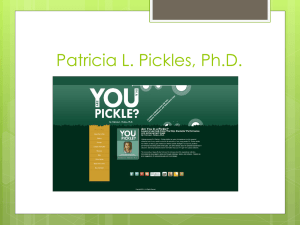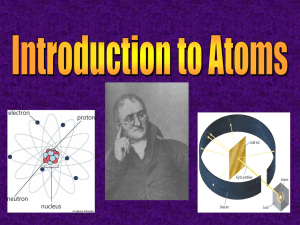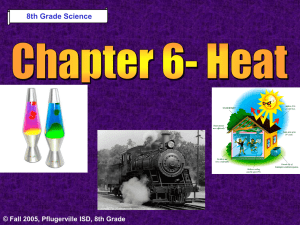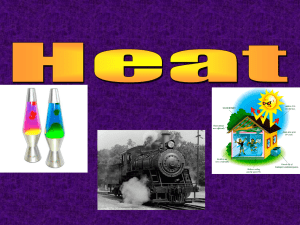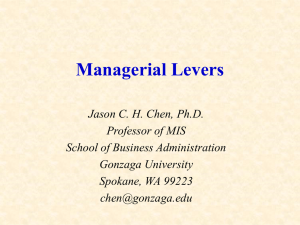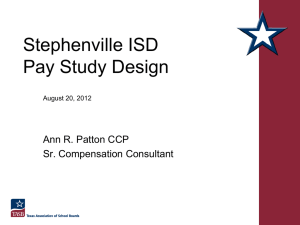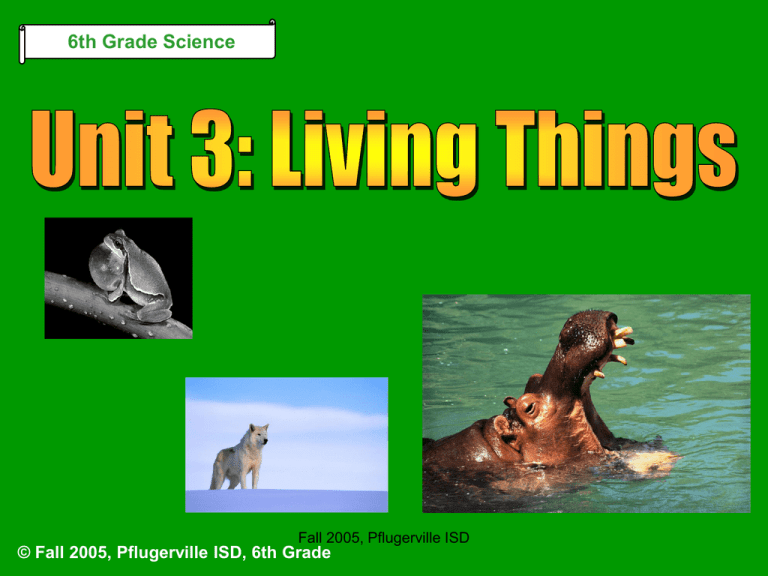
6th Grade Science
Fall 2005, Pflugerville ISD
© Fall 2005, Pflugerville ISD, 6th Grade
Unit 3
Living Things
Chapter 7: Cells: The Basic Units of Living Things
Section 1: Discovery and Diversity of Cells
Section 3: Organization of Living Things
Chapter 8: Population Changes and Heredity
Section 1. Changes Over Time
Section 2: How Do Populations Change Over Time?
Section 3: Natural Selection in Action
Section 4: Inheritance
Fall 2005, Pflugerville ISD
Discover and Diversity of Cells
Chapter 7 Section 1
Fall 2005, Pflugerville ISD
Discover and Diversity of Cells
What Do You Think?
Why weren’t cells discovered until
1665?
Chapter 7 Section 1
Fall 2005, Pflugerville ISD
Discover and Diversity of Cells
Robert Hooke first to describe the
cell.
In 1665, he built a microscope and
looked at cork or bark cells.
He looked at plants, feathers, fish
scales, and fly eyes.
Chapter 7 Section 1
Fall 2005, Pflugerville ISD
Cite: http://www.mcrit.com/COMSOC/persones_tecniques/Robert_Hooke_archivos/Robert_Hooke.jpg
Discover and Diversity of Cells
Anton van Leeuwenhook- looked at
protist under his own microscope.
He looked at blood cells and was the first
person to see bacteria.
He discovered yeast is a single-celled
organism.
Chapter 7 Section 1
Fall 2005, Pflugerville ISD
Cite: http://www.caribbeanedu.com/images/kewl/biomass01.gif
Discover and Diversity of Cells
Activity
Place a small dot of yogurt on a slide.
Add a drop of water and a cover-slip.
Use a microscope to examine the
slide. What do you see?
Chapter 7 Section 1
Fall 2005, Pflugerville ISD
See speaker notes for lab.
Discover and Diversity of Cells
All organisms are made of one or
more cells.
The cell is the basic unit of all
living things.
All cells come from existing cells.
Chapter 7 Section 1
Fall 2005, Pflugerville ISD
Discover and Diversity of Cells
The largest cell on Earth is the yolk
of an ostrich.
If the cell gets too large, the cell’s
surface area will not be large
enough to take in enough nutrients
or pump out enough waste.
Chapter 7 Section 1
Fall 2005, Pflugerville ISD
Cite: http://www.bhs.org.uk/Animated-Clips/ostrich.gif
Discover and Diversity of Cells
Cells
Cells
Parts of the Cell
Types of Cells
Cell Membrane
(barrier)
Eubacteria
Cytoplasm
(fluid in the cell)
Archaebacteria
Organelles
(help live + reproduce)
Nucleus
(control center)
Chapter 7DNA
Section 1
(genetic material)
Fall 2005, Pflugerville ISD
Eukaryotes
Discover and Diversity of Cells
A plant cell is easier to see than an
animal cell because of the cell wall.
Chapter 7 Section 1
Fall 2005, Pflugerville ISD
Discover and Diversity of Cells
Eubacteria- are the most common type of cells.
They live everywhere. They don’t have a
nucleus and they don’t have membrane-bound
organelles.
Archaebacteria- are not as common as
eubacteria. These cells are single-celled
organisms. They have circular DNA and they
lack a nucleus and membrane-bound
organelles.
Chapter 7 Section 1
Fall 2005, Pflugerville ISD
Discover and Diversity of Cells
Eukayotic – are the largest cells. These
cells have a nucleus and membranebound organelles.
Chapter 7 Section 1
Fall 2005, Pflugerville ISD
Discover and Diversity of Cells
Plant Cell Has:
Cytoplasm
Cell Membrane
Nucleus
Organelles
DNA
Cell Wall
Chloroplast
Define Each Word
Chapter 7 Section 1
Animal Cell has:
Cytoplasm
Cell Membrane
Nucleus
Organelles
DNA
Define Each Word
Fall 2005, Pflugerville ISD
Discover and Diversity of Cells
Activity
Learn how to use the microscope
by view what an animal cell and
plant cell look like. Draw and
label the parts of the cell you see.
Chapter 7 Section 1
Fall 2005, Pflugerville ISD
See speaker notes for lab.
Discover and Diversity of Cells
Review the cell parts and their functions
by clicking here.
Look at both an plant cell and a animal cell
and their parts.
Chapter 7 Section 1
Fall 2005, Pflugerville ISD
Pre-AP Extension
How are parts of a cell like a city?
How do the parts interact with one
another? Draw a plant or animal
cell, label all the parts and
compare the organelles to the
parts of a city.
Chapter 7 Section 1
Fall 2005, Pflugerville ISD
See speaker notes for lab.
Let’s Review
1. What basic structure carries out
functions to sustain life?
Chapter 7 Section 1
Fall 2005, Pflugerville ISD
Answer
Cells carry our functions to
sustain life.
Chapter 7 Section 1
Fall 2005, Pflugerville ISD
Let’s Review
2. Why are cells small?
Chapter 7 Section 1
Fall 2005, Pflugerville ISD
Answer
A large cell would be unable to
take I enough nutrients or get rid
of enough waste.
Chapter 7 Section 1
Fall 2005, Pflugerville ISD
Let’s Review
3. What are the three basic types of
cells, and how are they different?
Chapter 7 Section 1
Fall 2005, Pflugerville ISD
Answer
The three basic types of cells are
eubateria, archaebacteria, and
eukaryotes. Archaebacteria and
eubacteria don’ have a nucleus or
other membrane-bound
organelles, as eukaryotes do.
Chapter 7 Section 1
Fall 2005, Pflugerville ISD
The Organization of Living Things
Chapter 7 Section 3
Fall 2005, Pflugerville ISD
The Organization of Living Things
What Do You Think?
Why can’t you use your arm muscles
to digest food?
Chapter 7 Section 3
Fall 2005, Pflugerville ISD
The Organization of Living Things
The benefits to being multi-cellular
are:
– Many different cells allows organisms to
perform many functions.
– Each cell is specialized to do a
particular job.
Chapter 7 Section 3
Fall 2005, Pflugerville ISD
The Organization of Living Things
A tissue is a group
of cells that work
together to perform
a specific job.
Cardiac cells
make-up the
cardiac muscles.
Chapter 7 Section 3
Fall 2005, Pflugerville ISD
The Organization of Living Things
Animals have the following types of
tissue:
– Nerve tissues
– Muscle tissues
– Connective tissues
– Protective tissues
Chapter 7 Section 3
Fall 2005, Pflugerville ISD
The Organization of Living Things
Nerve Tissue
Chapter 7 Section 3
Fall 2005, Pflugerville ISD
Cite: http://www.anatomy.iupui.edu/courses/histo_D502/D502f02/Nerve/s414x.jpg
The Organization of Living Things
Muscle Tissue
Chapter 7 Section 3
Fall 2005, Pflugerville ISD
The Organization of Living Things
Connective Tissue
Chapter 7 Section 3
Fall 2005, Pflugerville ISD
The Organization of Living Things
Protective Tissue
Chapter 7 Section 3
Fall 2005, Pflugerville ISD
The Organization of Living Things
Plants have the following type of
tissue:
–Transport tissue
–Protective tissue
–Ground tissue
Chapter 7 Section 3
Fall 2005, Pflugerville ISD
The Organization of Living Things
Transport tissue moves
water and nutrients through
the plants.
Cite: http://www.biologie.uni-hamburg.de/b-online/library/onlinebio/xylem.gif
Chapter 7 Section 3
Fall 2005, Pflugerville ISD
The Organization of Living Things
The plant’s protective tissue
covers the plant.
Chapter 7 Section 3
Fall 2005, Pflugerville ISD
Cite:http://www.science.siu.edu/landplants/Anthocerophyta/images/Phaeoceros.stomate.JPEG
The Organization of Living Things
Ground tissue is where
photosynthesis takes place.
Cite: http://static.howstuffworks.com/gif/irrigation-photosynthesis.gif
Chapter 7 Section 3
Fall 2005, Pflugerville ISD
The Organization of Living Things
Tissues work together and
groups of tissues form an organ.
Cite: http://www.footdoc.ca/www.FootDoc.ca/Website_Animated_Heart_Beating.gif
Chapter 7 Section 3
Fall 2005, Pflugerville ISD
The Organization of Living Things
Levels of Organization
Organ
Tissue
Cell
Organ System
Chapter 7 Section 3
Fall 2005, Pflugerville ISD
The Organization of Living Things
Structure is the
shape of a part
and the material
the part is made
of.
Function is the
job the part
does.
Chapter 7 Section 3
Fall 2005, Pflugerville ISD
The Organization of Living Things
Activity
Even though the earthworm looks like a
simple organism, it has external and
internal parts that work together to help
the organism survive. Dissect an
earthworm to explore the parts of the
worm.
Chapter 7 Section 3
Fall 2005, Pflugerville ISD
The Organization of Living Things
Anything that
can live on its
own is an
organism.
An organism that
is singled celled
is called
unicellular.
Chapter 7 Section 3
Bacteria
Fall 2005, Pflugerville ISD
Cite: http://www.aradio.co.uk/caption/bacteria.jpg
Pre-AP Extension
The nervous system involves the
brain, spinal cord, peripheral nerves
and the sensory organ. One function
of the nervous system is reflexes.
Test your reflexes to see how quickly
your brain and nerves respond to
stimuli.
Chapter 7 Section 3
Fall 2005, Pflugerville ISD
See speaker notes for lab.
Let’s Review
1. What are tissues made of?
What are organs made of?
Chapter 7 Section 3
Fall 2005, Pflugerville ISD
Answer
Cell; tissues
Chapter 7 Section 3
Fall 2005, Pflugerville ISD
Let’s Review
2. Differentiate between structure
and function in organ systems
using the lung and heart as an
example.
Chapter 7 Section 3
Fall 2005, Pflugerville ISD
Answer
The structure of the lungs is a group of
sacs surrounded by small blood vessels.
The function of the lungs is to exchange
gases. Oxygen enters the bloodstream.
Carbon dioxide enters the sac and is
breathed out. The heart is a set of
muscular chambers. When a chamber
contracts, it pushes blood to its next
destination. Valves keep the blood from
moving backwards.
Chapter 7 Section 3
Fall 2005, Pflugerville ISD
Change Over Time
Chapter 8 Section 1
Fall 2005, Pflugerville ISD
Change Over Time
What Do You Think?
What is a fossil?
Chapter 8 Section 1
Fall 2005, Pflugerville ISD
Change Over Time
Inherited
Characteristics- passed
from one generation to
another and can change
over time. This is
known as evolution.
Population – is a group
of the same kind of
organism living in the
same place
Chapter 8 Section 1
Fall 2005, Pflugerville ISD
Cite:http://www.kmc.org/Services/family_tree.jpg
Change Over Time
Favorable
characteristics
that enable an
organism to live
and reproduce will
be passed to the
next generation.
Chapter 8 Section 1
Fall 2005, Pflugerville ISD
Cite: http://www.spacedaily.com/images/evolution-body-400mil-bg.jpg
Change Over Time
Fossils are used
to study organisms
of the past.
A fossil is physical
evidence of a living
thing.
Trilobite
Chapter 8 Section 1
Fall 2005, Pflugerville ISD
Cite: http://www.canadianrockhound.ca/junior/fossils_trilobite_greepos.jpg
Change Over Time
Fossils are
found in the
old layers of
the earth’s
crust.
Chapter 8 Section 1
Fall 2005, Pflugerville ISD
Cite: http://pubs.usgs.gov/gip/geotime/fossils.gif
Change Over Time
Cite: http://www.envs.emory.edu/Research1/fossil-footprint.jpg
Trace fossils are
evidence of animal
activity like a footprint.
Mold is a cavity in rock
where a plant or animal
was buried.
Cast is a cavity is filled in
with minerals, sand or
dust.
Cast
Chapter 8 Section 1
Fall 2005, Pflugerville ISD
Foot print
Mold
Change Over Time
Click here to observe how a fossil
can form.
Chapter 8 Section 1
Fall 2005, Pflugerville ISD
Change Over Time
Activity
Flatten some clay and place it into the
bottom of a cup. Press a seashell into the
clay. Pour some plaster of Paris into the
cup on top of the shell. Let it dry.
Remove the everything the next day.
What kind of fossil did you make?
See speaker notes for lab.
Chapter 8 Section 1
Fall 2005, Pflugerville ISD
Change Over Time
The fossil
record is the
timeline of life.
The deeper
into the earth’s
crust the older
the fossil.
Chapter 8 Section 1
Fall 2005, Pflugerville ISD
Cite: http://imnh.isu.edu/digitalatlas/geo/basics/imgs/small.gif
Change Over Time
There is a gap in the
fossil records due to
present conditions.
In order for a fossil
to form there needs
to be a lack of
oxygen.
The ocean is the best place for
fossils to form. Why?
Chapter 8 Section 1
Fall 2005, Pflugerville ISD
Cite: http://www.ruggedelegantliving.com/journal/images/2003/05/11/ocean.floor.jpg
Change Over Time
Bones have
modified to fit
their function
over time.
Dolphin
flipper
Bat wing
Chapter 8 Section 1
Fall 2005, Pflugerville ISD
Cite: http://courses.washington.edu/vertebra/453/photos/skeleton_photos/bat_wing_new.jpg
Change Over Time
Adaptations are
characteristics that
help an organism
survive and reproduce
in its environment.
Example: smoky
jungle frog.
Chapter 8 Section 1
Fall 2005, Pflugerville ISD
Cite: http://www.cloudforestvoices.com/CFVimages/Leptodactylus%20pentadactylus%20side%20low.JPG
Change Over Time
Activity
Take 25 colored marshmallows and 25
white marshmallows and spread them out.
Ask you partner to pick the first
marshmallow he or she sees. Do this 10
times. What was the most common color
marshmallow your partner picked? Why?
Chapter 8 Section 1
Fall 2005, Pflugerville ISD
See speaker notes for lab.
Change Over Time
The individuals that
are better adapted
to their environment
are more likely to
pass their traits to
future generations.
Chapter 8 Section 1
Fall 2005, Pflugerville ISD
Cite: http://www.holtz.org/library/Images/Natural%20Science/DNA%20animation.gif
Pre-AP Extension
Fossils are traces of organisms that lived
in the past. The age and morphologies
(appearances) of fossils can be used to
place fossils in sequences that often show
patterns of changes that have occurred
over time. Analyze the characteristics of
fossils and compare placement of fossils
over time.
Chapter 8 Section 1
Fall 2005, Pflugerville ISD
See speaker notes for lab.
Let’s Review
1. How can the fossil record be
used to suggest that living things
have changed over time?
Chapter 8 Section 1
Fall 2005, Pflugerville ISD
Answer
Fossils provide a historical
sequence of life. The deeper in
the Earth’s crust fossils are fund,
the less they look like present day
organisms.
Chapter 8 Section 1
Fall 2005, Pflugerville ISD
Let’s Review
2. Characteristics that help
organisms survive and reproduce
are called_______.
Chapter 8 Section 1
Fall 2005, Pflugerville ISD
Answer
Adaptations are characteristics
that help an organism survive and
reproduce in its environment.
Chapter 8 Section 1
Fall 2005, Pflugerville ISD
How Do Populations Change?
Chapter 8 Section 2
Fall 2005, Pflugerville ISD
How Do Populations Change?
What Do You Think?
How do you explain the presents
of fossil shells on top of
mountains?
Chapter 8 Section 2
Fall 2005, Pflugerville ISD
How Do Populations Change?
Charles Darwin
traveled around the
world as a
naturalist.
He visited the
Galapagos islands965 miles west of
Ecuador.
Cite: http://www.pbs.org/faithandreason/media/darwin.lg.jpg
Chapter 8 Section 2
Fall 2005, Pflugerville ISD
How Do Populations Change?
The animals on the
Galapagos Islands
are similar to the
animals on Ecuador
although the finches
were different.
Their beaks adapted
to the way they fed.
Chapter 8 Section 2
Cite: http://images.cnn.com/EARTH/9707/17/galapagos/galapagos.lg.jpg
Fall 2005, Pflugerville ISD
Cite: http://eob.gsfc.nasa.gov/Newsroom/NewImages/Images/Galapagos.A2002071.1625.jpg
How Do Populations Change?
Traits are distinguishing qualities that can
be passed from parents to offspring.
Selective breeding is when humans
select which plants or animals will
reproduce based on certain traits.
Dogs are a good example of selective
breeding.
Chapter 8 Section 2
Fall 2005, Pflugerville ISD
How Do Populations Change?
Selective Breeding
Cite: http://home.flash.net/~ceramics/h810028.jpg
Chapter 8 Section 2
Fall 2005, Pflugerville ISD
How Do Populations Change?
Darwin was impressed
that farmers could make
large changes in just a
few generations.
He learned from
geologist that the Earth
was older than first
thought according to
Charles Lyell.
Chapter 8 Section 2
Fall 2005, Pflugerville ISD
Cite: http://www.lyellcollege.com/assets/images/Charles_Lyell.jpg
How Do Populations Change?
Thomas Malthus study the
population growth in Europe in
1700’s.
He thought that there would be
too many people and not
enough food. Hunger, sickness
and food help keep population
under control.
Darwin thinks this is the same
for animals and plants.
Chapter 8 Section 2
Fall 2005, Pflugerville ISD
Cite: http://www.biblicalcreation.co.uk/images/malthus.gif
Cite: http://www.ldeo.columbia.edu/edu/dees/courses/v1001/images/malthus.jpg
How Do Populations Change?
On the Origin of
Species by Charles
Darwin.
The book states that
organisms that are best
adapted to their
environment are more
likely to survive and
reproduce - natural
selection.
Chapter 8 Section 2
Fall 2005, Pflugerville ISD
Cite: http://www.loc.gov/exhibits/freud/images/vc008368.jpg
How Do Populations Change?
1. Overpopulationmore offspring born
then will live to
adulthood.
2. Differences in a
Population- same
species are different
from one another.
Chapter 8 Section 2
Fall 2005, Pflugerville ISD
Cite:http://home.nc.rr.com/mediateknic/rabbits.jpg
How Do Populations Change?
3. Struggle to
survive- not
enough food for
all to survive.
4. Successful
Reproductionfind a mate to
reproduce.
Chapter 8 Section 2
Fall 2005, Pflugerville ISD
How Do Populations Change?
Go to http://www2.edc.org/weblabs and
click on Natural Selection to explore
Darwin’s theory of Natural Selection.
Chapter 8 Section 2
Fall 2005, Pflugerville ISD
Let’s Review
1. What traits changed in the
Galapagos finches as they
adapted to the different islands?
Chapter 8 Section 2
Fall 2005, Pflugerville ISD
Answer
The beaks of the Galapagos
finches adapted to the different
ways the birds get food.
Chapter 8 Section 2
Fall 2005, Pflugerville ISD
Let’s Review
2. How do farmers get animals and
plants with desired traits?
Chapter 8 Section 2
Fall 2005, Pflugerville ISD
Answer
Farmers allow only the plants and
animals with the desired traits to
breed.
Chapter 8 Section 2
Fall 2005, Pflugerville ISD
Natural Selection in Action
Chapter 8 Section 3
Fall 2005, Pflugerville ISD
Natural Selection in Action
What Do You Think?
Why must you finish your
antibiotics when you have an
infection?
Chapter 8 Section 3
Fall 2005, Pflugerville ISD
Natural Selection in Action
Bacteria can be
resistant to
antibiotics.
They can pass
this trait on to
their offspring.
Chapter 8 Section 3
Fall 2005, Pflugerville ISD
Cite: http://www.adrian.edu/chemistry/th/Somelinks/Spages/jtessmer/0398_levy_big_bacteria.gif
Natural Selection in Action
Dark peppered moths
rare before 1850, but
now more common.
Reason- dark moths
were easy to see for
prey ( birds) but added
smoke after 1850
made it hard to see the
dark moths.
Chapter 8 Section 3
Fall 2005, Pflugerville ISD
Cite: http://www.curentbum.org/reference/encyclopaedia/hutchinson/images/0008n064.jpg
Natural Selection in Action
Species are a group
of organisms that can
mate with one
another to produce
fertile offspring.
New Species can
form after a group
gets separated
from original
population.
Speciation- when
a single species
divides into two.
Chapter 8 Section 3
Fall 2005, Pflugerville ISD
Cite: http://taxonomy.zoology.gla.ac.uk/~rdmp1c/teaching/L1/Evolution/l6/speciation.jpg
Natural Selection in Action
Grand Canyon
environment is
different on both
sides.
More rain on the
north side than
the south thus
speciation can
occur.
Chapter 8 Section 3
Fall 2005, Pflugerville ISD
Cite: http://williamcalvin.com/bk3/img/kaibab.gif
Natural Selection in Action
Explore animal adaptation and see how
animals adapt to their environment.
Click here
Chapter 8 Section 3
Fall 2005, Pflugerville ISD
Pre-AP Extension
Protective coloration helps some
animals to survive in nature.
Model predatory behavior while
feeding on toothpick (insects)
prey in an outdoor area.
Chapter 8 Section 3
Fall 2005, Pflugerville ISD
See speaker notes for lab.
Let’s Review
1. How did the traits of the
peppered moth population in
industrial areas of Europe change
after 1850?
Chapter 8 Section 3
Fall 2005, Pflugerville ISD
Answer
After the 1850s, the population of
dark-colored peppered moths
increased, and the population of
light-colored peppered moths
decreased.
Chapter 8 Section 3
Fall 2005, Pflugerville ISD
Let’s Review
2. How do you think speciation
affected the Galapagos finches?
Chapter 8 Section 3
Fall 2005, Pflugerville ISD
Answer
Accept any reasonable answer.
Chapter 8 Section 3
Fall 2005, Pflugerville ISD
Inheritance
Chapter 8 Section 4
Fall 2005, Pflugerville ISD
Inheritance
What Do You Think?
Where did you get your eye color
from?
Chapter 8 Section 4
Fall 2005, Pflugerville ISD
Inheritance
Gregor Mendel grew up in
Heinzendorf, Austria on
the family farm.
There he learned a great
deal about flowers and
plants.
Cite: http://mendel.imp.univie.ac.at/mendeljsp/images/mendel2.jpg
Chapter 8 Section 4
Fall 2005, Pflugerville ISD
Inheritance
Mendel noticed
that some traits
appeared in one
generation but not
in another.
To find out Mendel
decided to study
peas.
Chapter 8 Section 4
Fall 2005, Pflugerville ISD
Cite: http://biology.kenyon.edu/courses/biol114/KH_lecture_images/Mendel/FG10_02a.JPG
Inheritance
Mendel decided to
study one trait at a
time.
One trait always
appeared while the
other trait vanished.
First- generation is
the offspring of the
breeding of plants.
Chapter 8 Section 4
Fall 2005, Pflugerville ISD
Cite: http://www.accessexcellence.org/RC/AB/WYW/wkbooks/PAP/PAPg/inheritance.gif
Inheritance
Proteins act as
chemical
messengers.
Proteins are the
reason why living
things come in all
shapes and sizes.
Chapter 8 Section 4
Fall 2005, Pflugerville ISD
Cite: http://www.mbbnet.umn.edu/icons/chromosome.jpeg
Inheritance
Asexual is a single
parent produces
offspring that are
exactly like the
parent.
Most single-celled
organisms are
asexual.
Chapter 8 Section 4
Sexual are two
parents produce an
offspring that is not
exactly like the
parents.
Sex cells combine
and get half of its
genes from the
mother and half
from the father.
Fall 2005, Pflugerville ISD
Inheritance
Go to http://www2.edc.org/weblabs/ and
select Mendel’s Peas. Explore the
characteristics Mendel studied.
Chapter 8 Section 4
Fall 2005, Pflugerville ISD
Inheritance
Activity
Have you noticed the different eye color,
hair color and different types of earlobes of
your classmates? Create a table for each
trait and count the number of classmates
with each trait. What are some common
traits?
Chapter 8 Section 4
Fall 2005, Pflugerville ISD
See speaker notes for lab.
Pre-AP Extension
Collect data from your class of who has
different dominant traits. Some traits to
look for are: tongue rolling, free earlobe,
interlocking fingers, dimples, bent little
finger, double jointed thumbs, freckles,
PTC taste and widow’s peak. Create a
graph use Excel with your results.
Chapter 8 Section 4
Fall 2005, Pflugerville ISD
Let’s Review
1. What are genes, and what role
do they play in inheritance?
Chapter 8 Section 4
Fall 2005, Pflugerville ISD
Answer
Genes are sections of DNA that
spell out sequences of amino
acids for specific proteins.
Proteins determine your traits.
Chapter 8 Section 4
Fall 2005, Pflugerville ISD
Let’s Review
2. What is the difference between
recessive traits and dominant
traits?
Chapter 8 Section 4
Fall 2005, Pflugerville ISD
Answer
Dominant traits occur most often
and recessive traits seem to
disappear yet can reappear at
any time.
Chapter 8 Section 4
Fall 2005, Pflugerville ISD


